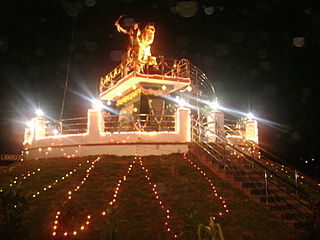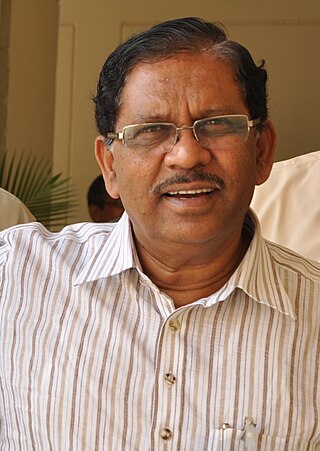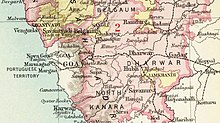
Hubli is a city in the Indian state of Karnataka. The twin cities Hubli–Dharwad form the second largest city in the state by area and population and the largest city in North Karnataka. Hubli is in Dharwad district of Karnataka and is the taluk headquarters of Hubli City and Hubli Rural. Although it hosts the HDMC office, the district headquarters is in Dharwad.

Bijapur is the district headquarters of Bijapur district of the Karnataka state of India. It is also the headquarters for Bijapur Taluk. Bijapur city is well known for its historical monuments of architectural importance built during the rule of the Adil Shahi dynasty. It is also well known for the popular Karnataka premier league team, the Bijapur Bulls. Bijapur is located 519 km (322 mi) northwest of the state capital Bangalore and about 550 km (340 mi) from Mumbai and 210 km (130 mi) north east of the city of Belgaum.

Dharwad, also known as Dharwar, is a city located in the northwestern part of the Indian state of Karnataka. It is the headquarters of the Dharwad district of Karnataka and forms a contiguous urban area with the city of Hubballi. It was merged with Hubballi in 1962 to form the twin cities of Hubballi-Dharwad. It covers an area of 213 km2 (82 sq mi) and is located 430 km (270 mi) northwest of Bangalore, on NH-48, between Bangalore and Pune.

Vinayaka Krishna Gokak, abbreviated in Kannada as Vi. Kru. Gokak, was an Indian writer in the Kannada language and a scholar of English and Kannada literatures. He was the fifth writer to be honoured with the Jnanpith Award in 1990 for Kannada language, for his epic Bharatha Sindhu Rashmi. Bharatha Sindhu Rashmi deals with the Vedic age and is perhaps the longest epic narrative in any language in the 20th century. In 1961, Gokak was awarded the Padma Shri from the Government of India for Dyava Prithvi.

Gokak is a taluka headquarters in the Belagavi district of Karnataka state, India. It is located around 70 km from Belagavi at the confluence of two rivers, the Ghataprabha and the Markandeya. The population of the city is according to 2011 census is 79,121. Gokak city has second highest GDP in the district of Belagavi after Belagavi city. The common language is Kannada.

Kittur, historically as Kittoor, is a town in the Belagavi district of the Indian state of Karnataka. It was part of Bailhongal taluka but was declared as an independent taluka on 23 October 2012 by the Chief Minister of Karnataka on the inauguration of Kittur Utsav. It is 177th Taluk of Karnataka State. It is a place of historical importance because of the armed rebellion of Kittur Chennamma (1778–1829), Rani of the State of Kittur against the British East India Company, during which a British Commissioner, St John Thackeray was killed.

The Deccan States Agency, also known as the Deccan States Agency and Kolhapur Residency, was a political agency of India, managing the relations of the Government of India with a collection of princely states and jagirs in western India.

North Karnataka is a geographical region in Deccan plateau from 300 to 730 metres elevation that constitutes the region of the Karnataka state in India and the region consists of 14 districts. It is drained by the Krishna River and its tributaries the Bhima, Ghataprabha, Malaprabha, and Tungabhadra. North Karnataka lies within the Deccan thorn scrub forests ecoregion, which extends north into eastern Maharashtra.
Savanuru is a locality and taluk headquarters of Savanuru Taluk in Haveri District of Karnataka state, India.
The Karnataka Vidyavardhaka Sangha was an institution established on 20 July 1890 by Sri R H Deshpande in Dharwad, India which was then under the British rule of Bombay Presidency. This institution was established with the sole objective of promoting Kannada culture and language in times when the Kannada speaking regions of present-day Karnataka were split into six different areas, where Kannada was often overshadowed by other languages. Soon the Sangha morphed into a hub for the Karnataka Ekikarana (Unification) movement and played a pivotal role in the eventual unification of Karnataka. It inspired the establishment of several institutions and organisations across the state. For its invaluable services and contributions to Kannada and Karnataka, this institution was awarded the Ekikarana Award by the Government of Karnataka on the occasion of the 50th year celebrations of Karnataka state in 2006.
Sira is a taluk of Tumkur district in the state of Karnataka, India. Its headquarters, Sira city lies on the NH 48 .It is the largest taluk in district by area.Second largest in population and economy.It is most developed regions in district after headquarters.

Talakadu Srinivasaiah Nagabharana, commonly known as T. S. Nagabharana, is an Indian film director, in the Kannada film industry and a pioneer of parallel cinema. He is one of the few film directors to have straddled the mainstream and parallel cinema worlds.

The Siege of Trichinopoly was part of an extended series of conflicts between the Nizam of Hyderabad and the Maratha Empire for control of the Carnatic region. On 29 August 1743, after a six-month siege, Murari Rao surrendered, giving Nizam ul Mulk (Nizam) the suzerainty of Trichinopoly. By the end of 1743, the Nizam had regained full control of Deccan. This stopped the Maratha interference in the region and ended their hegemony over the Carnatic. The Nizam resolved the internal conflicts among the regional hereditary nobles (Nawabs) for the seat of governor (Subedar) of Arcot State, and monitored the activities of the British East India company and French East India Company by limiting their access to ports and trading.

Jamkhandi State was one of the Maratha princely states of British India. It was founded in 1811 and its capital was at Jamakhandi. It was administered as part of the Deccan States Agency of the Bombay Presidency and was one of the former states of the Southern Maratha Country. The area that was under this princely state is part of present day Karnataka.

Mudhol State was a princely state during the British Raj. The rulers were from the Ghorpade Dynasty of the Marathas. It was one of the former states of the Southern Maratha Country and its capital was the city of Mudhol in present-day Bagalkote District of Karnataka State in India. The last ruler was HH Shrimant Raja Bhairavsinhrao Malojirao Ghorpade II. Mudhol acceded to the Dominion of India on 8 March 1948, and is currently a part of Karnataka state.
At present there is no official flag for the state of Karnataka in India. However a number of historical and cultural flags have been used in the state.

GangadharaiahParameshwara is an Indian politician who is currently serving as the Home Minister of Karnataka since 27 May 2023. He has also served as the seventh Deputy Chief Minister of Karnataka, and longest-serving President of the Karnataka Pradesh Congress Committee for two consecutive terms.

Bangalore, officially Bengaluru, is the capital and largest city of the southern Indian state of Karnataka. It has a population of more than 8 million and a metropolitan population of around 15 million, making it India's third most populous city and fourth most populous urban agglomeration. It is the most populous city and largest urban agglomeration in South India, and is the 27th largest city in the world. Located on the Deccan Plateau, at a height of over 900 m (3,000 ft) above sea level, Bangalore has a pleasant climate throughout the year, with its parks and green spaces earning it the reputation of India's "Garden City". Its elevation is the highest of India's major cities.

Ravi Basrur is an Indian music composer, sound designer, lyricist and director who mostly works in the Kannada film industry and is known for his collaborations with director Prashant Neel, with whom he debuted in Ugramm. He also works as a film director, having directed the films Gargar Mandala and Girmit.

Satyabodha Tirtha was an Indian philosopher, scholar, yogi, mystic and saint. He was the 25th pontiff of Uttaradi Math and served the pontificate from March 1744 - 9 March 1783. Satyabodha Tirtha was a great yogi and was honoured by both Hindu and Muslim rulers of his time. Satyabodha Tirtha enjoyed a good fame as a miracle-man. Almost all the princes of the South India used to worship him and were his ardent disciples. Murari Rao of Gooty, Raghoji Bhosale and Fateh Singh Rao Gaekwad, were his great disciples. Satyabodha Tirtha Swamiji's mission of peace has played a prominent role during this time. He earned a reputation as the greatest of Madhva saints of his time for his un-rivaled scholarship, miraculous achievements and dynamism as the pontiff of the Uttaradi Math. So many were his achievements and so well was he liked, admired and respected by people of all castes and creeds, rich and poor, that the Uttaradi Math in Savanur got the name as Satyabodha Math after him. Satyabodha Tirtha is believed to be the incarnation of Markandeya.

















